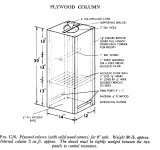Hahah, how crazy is this, rght!?!
Well, I simply don't have time to build a new cabinet.
But I have an incredibly well built tower cabinet that I can re-purpose.
The problem is, it has one flaw.
It's got bottom-to-top resonance!
I dont know how I overlooked that when I built it.
Anyhow, my new speakers require a much, much smaller enclosure volume.
I will be crossing these over at 80hz to a subwoofer.
So I want to take 22" of height away from it.
But, from the bottom. Because I need the overall height or I'd have to make speaker stands.
At first I thought I'd just fill it with concrete.
But it seems that even just 1.5 ft3 of concrete is a massive undertaking and a couple hundred pounds.
I had no idea!
Can anyone think of a way to reduce the internal height and volume?
Some sort of liquid, like plaster of paris, that could be poured in the bottom and then would harden like a rock.
Well, I simply don't have time to build a new cabinet.
But I have an incredibly well built tower cabinet that I can re-purpose.
The problem is, it has one flaw.
It's got bottom-to-top resonance!
I dont know how I overlooked that when I built it.
Anyhow, my new speakers require a much, much smaller enclosure volume.
I will be crossing these over at 80hz to a subwoofer.
So I want to take 22" of height away from it.
But, from the bottom. Because I need the overall height or I'd have to make speaker stands.
At first I thought I'd just fill it with concrete.
But it seems that even just 1.5 ft3 of concrete is a massive undertaking and a couple hundred pounds.
I had no idea!
Can anyone think of a way to reduce the internal height and volume?
Some sort of liquid, like plaster of paris, that could be poured in the bottom and then would harden like a rock.
Attachments
Plaster is much lighter than concrete, but still not light. Maybe you could mix in Styrofoam packing peanuts with the plaster.
Is there no way to get in there and seal off the volume with a wooden partition?
Is there no way to get in there and seal off the volume with a wooden partition?
It's got lots of internal bracing. So it would be very difficult.
Not impossible though.
I just like the idea of pouring something in and walking away a few hours.
Anything else will almost be like building an entire new enclosure!
Not impossible though.
I just like the idea of pouring something in and walking away a few hours.
Anything else will almost be like building an entire new enclosure!
You know what, I just modeled three famous Klipsch tower horn speakers and all three had dimensions which Boxnotes says will experience top-to-bottom resonance between 150-200hz.
What's up with that?
What's up with that?
Thank you.
I may have to restort to creating wood blocks to reduce internal volume as much as possible.
And then implement some sort of acoustic filter as you have suggested, to reduce top to bottom resonance.
I may have to restort to creating wood blocks to reduce internal volume as much as possible.
And then implement some sort of acoustic filter as you have suggested, to reduce top to bottom resonance.
Any reason why 42 empty, but sealed, one litre plastic water bottles wouldn't work?
Perhaps they would be acoustically transparent.
Perhaps they would be acoustically transparent.
Perhaps they would be acoustically transparent.
I fear they would behave like glorified styrofoam.
What´s wrong with filling them up with water?
Or concrete?
You know what, I just modeled three famous Klipsch tower horn speakers and all three had dimensions which Boxnotes says will experience top-to-bottom resonance between 150-200hz.
What's up with that?
They are highlighted in red because you have "Display resonances under 200Hz" selected in the Graphing Options menu. Any subwoofer taller than around 1 meter will start to be impacted by this value, and display that resonance in red.
Ideally no two resonances should coincide, which the internal bracing on your cabinet should already insure.
Water inside a speaker enclosure?
Sounds waves excite water quite a bit.
And can travel through water.
Is it something I should even consider?
Weltersys, thank you for the clarification.
Sounds waves excite water quite a bit.
And can travel through water.
Is it something I should even consider?
Weltersys, thank you for the clarification.
This talk of water has me rethinking plaster of paris.
Mixing Plaster of Paris | Craft Recipes & How-To's | FirstPalette.com.
18x12x18 is what I need to lose.
This is 1.53 cubic feet.
1 Cubic Foot = 7.5 Gallons, so I would need 11.45 gallons per speaker.
Water weighs 8.34 pounds per gallon.
That would add up to only 95lbs per speaker.
Mix two parts Plaster of Paris to one part Water.
This 25lb bag is only $18.
https://www.homedepot.com/p/DAP-25-...er walls with,20-30 minutes without shrinking.
Mixing Plaster of Paris | Craft Recipes & How-To's | FirstPalette.com.
18x12x18 is what I need to lose.
This is 1.53 cubic feet.
1 Cubic Foot = 7.5 Gallons, so I would need 11.45 gallons per speaker.
Water weighs 8.34 pounds per gallon.
That would add up to only 95lbs per speaker.
Mix two parts Plaster of Paris to one part Water.
This 25lb bag is only $18.
https://www.homedepot.com/p/DAP-25-...er walls with,20-30 minutes without shrinking.
...Anyhow, my new speakers require a much, much smaller enclosure volume.
...I will be crossing these over at 80hz to a subwoofer...
...Can anyone think of a way to reduce the internal height and volume?
Simulation of 3012 LFA in 100 vs. 42 litres shows a not very large difference in Qtb, 0.42 vs. 0.52.
I would fill the unwanted cavity with closed cell foam and treat the rest of the desired volume with poly wadding to suppress the air resonance that this new internal height will introduce.
Both closed cell foam and epoxy would be fairly expensive.
I think a gallon of epoxy was something like $100+ when I researched it earlier.
But now I like the idea of someday building a plexiglass speaker stand filled with marbles & epoxy.
I think a gallon of epoxy was something like $100+ when I researched it earlier.
But now I like the idea of someday building a plexiglass speaker stand filled with marbles & epoxy.
Wouldn't need a gallon. You could probably put styrofoam peanuts in first, top with marbles, and then thicken the epoxy to increase its viscosity. You can thicken with something as inexpensive as sawdust. Also, try a reasonably quick setting epoxy, as opposed to the long setting - it'll 'clump up' and set faster. You're just after a solid layer of epoxy/marbles which will also bond to the cabinet.I
- Home
- Loudspeakers
- Multi-Way
- Drastic enclosure surgery needed. Reduce 22" height & 42 liters volume


